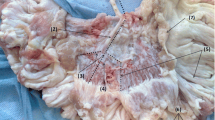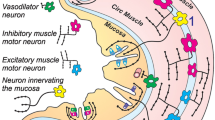Abstract
With the development of specific antibodies to vasoactive peptides and application of immunohistochemistry and radioimmunoassay methods, knowledge of vascular innervation has grown rapidly. In the cerebral circulation, four possible neurotransmitters are present: norepinephrine, acetylcholine, vasoactive intestinal peptide (VIP), and substance P. There is a dense adrenergic innervation of cerebral arteries, but contractile responses to nerve stimulation or circulating catecholamines are relatively small both in vitro and in vivo. Recent studies using radioligand binding techniques indicate a lack of specific3H-prazosin binding in cerebral arteries, in contrast to other vascular beds. Thus a lack of α1-adrenergic receptors in cerebral arteries may account for weak responsiveness to sympathetic stimulation. Both VIP and acetylcholine may be vasodilator neurotransmitters, but blockade of cholinergic responses does not alter neurogenic vasodilation. The lack of specific VIP antagonists hampers efferots to explore this system more fully. Substance P-containing nerves are affected by capsaicin, supporting the hypothesis that these are primary sensory afferents, perhaps mediating pain. Future work in this area may focus on defining the pathways of these nerves and exploring the role of co-transmitters and possible interactions between nerves. With this basic information, experiments can be designed to elucidate more clearly the functional roles these nerves play.
Similar content being viewed by others
References
Banner, W., S.P. Duckles, and H.I. Yamamura. Differentiation of vascular alpha1 and alpha2 adrenergic receptor sites using radioligand binding techniques. Abstract.Circulation. 66:II-72, 1982.
Bevan, J.A., R.D. Bevan, and S.P. Duckles. Adrenergic regulation of vascular smooth muscle. In:Handbook of Physiology, Section 2: The Cardiovascular System. Volume II, Vascular Smooth Muscle, edited by D.F. Bohr, A.P. Somlyo and H.V. Sparks. Baltimore: Williams & Wilkins, 1980, pp. 515–566.
Bill, A. and J. Linder. Sympathetic control of cerebral blood flow in acute arterial hypertension.Acta Physiol. Scand. 96: 114–121, 1976.
Buck, S.H., J.H. Walsh, and H.I. Yamamura, and T.F. Burks. Neuropeptides in sensory neurons.Life Sci. 30: 1857–1866, 1982.
Duckles, S.P. Neurogenic dilator and constrictor responses of pial arteriesin vitro: Differences between dogs and sheep.Circ. Res. 44:482–490, 1979.
Duckles, S.P. Comparison of3H-norepinephrine and3H-metaraminol accumulation as indices of adrenergic nerve density in rabbit blood vessels.Eur. J. Pharmacol. 67:355–361, 1980.
Duckles, S.P. Vasodilator innervation of cerebral blood vessels. InVasodilation, edited by P.M. Vanhoutte & I. Leusen, New York: Raven Press, 1981, pp. 27–38.
Duckles, S.P. Evidence for a functional cholinergic innervation of cerebral arteries.J. Pharmacol. Exp. Ther. 217:544–548, 1981.
Duckles, S.P. and J.A. Bevan. Pharmacological characterization of adrenergic receptors of a rabbit cerebral arteryin vitro.J. Pharmacol. Exp. Ther. 197: 371–378, 1976.
Duckles, S.P. and S.H. Buck. Substance P in the cerebral vasculature: Depletion by capsaicin suggests a sensory role.Brain Res. 245:171–174, 1982.
Duckles, S.P. and R. Rapoport. Release of endogenous norepinephrine from a rabbit cerebral artery.J. Pharmacol. Exp. Ther. 211:219–224, 1979.
Duckles, S.P. and S.I. Said. Vasoactive intestinal peptide as a neuro-transmitter in the cerebral circulation.Eur. J. Pharmacol. 78: 371–374, 1982.
Edvinsson, L., J. Fahrenkrug, J. Hanko, C. Owman, F. Sundler, and R. Uddman. VIP (Vasoactive Intestinal Polypeptide)-containing nerves of intracranial arteries in mammals.Cell Tissue Res. 208: 135–142, 1980.
Florence, V. and J.A. Bavan. Biochemical determinations of cholinergic innervation in cerebral arteries.Circ. Res. 45:212–218, 1979.
Florence, V.M., W.R. Hume, and M.L. Matsunaga. Choline acetyltransferase activity in the sympathetic nerves of the rabbit ear artery.Br. J. Pharmacol. 73: 721–724, 1981.
Furchgott, R.F. and J.V. Zawadski. The obligatory role of endothelial cells in the relaxation of arterial smooth muscle by acetylcholine.Nature (London). 288: 373–376, 1980.
Furness, J.B., R.E. Papka, N.G. Della, M. Costa, and R.L. Eskay. Substance P-like immunoreactivity in nerves associated with the vascular system of guinea pigs.Neuroscience. 7: 447–459, 1982.
Gamse, R., P. Holzer, and F. Lembeck. Decrease of substance P in primary afferent neurones and impairment of neurogenic plasma extravasation by capsaicin.Br. J. Pharmacol. 68: 207–213, 1980.
Heistad, D.D. and M.L. Marcus, editors.Cerebral Blood Flow: Effect of Nerves and Neurotransmitters. New York: Elsevier, 1982, pp. 1–561.
Heistad, D.D., M. Marcus, D. Busija, and S. Sadoshima. Protective effects of sympathetic nerves in the cerebral circulation. InCerebral Blood Flow: Effects of Nerves and Neurotransmitters, edited by D.D. Heistad and M.L. Marcus. New York: Elsevier North Holland, 1982, pp. 267–273.
Lee, T.J.-F. Direct evidence against acetylcholine as the dilator transmitter in the cat cerebral artery.Eur. J. Pharmacol. 68: 393–394, 1980.
Lee, T.J-F., C.C. Chuieh, and M. Adams. Synaptic transmission of vasoconstrictor nerves in rabbit basilar artery.Eur. J. Pharmacol. 61: 55–70, 1980.
Lee, T.J-F., W.R. Hume, C. Su, and J.A. Bevan. Neurogenic vasodilation of cat cerebral arteries.Circ. Res. 42: 535–542, 1978.
Lee, T.J-F., C. Su, and J.A. Bevan. Neurogenic sympathetic vasoconstriction of the rabbit basilar artery.Circ. Res. 39: 120–126, 1976.
Lembeck, F. and P. Holzer. Substance P as neurogenic mediator of antidromic vasodilation and neurogenic plasma extravasation.N.S. Arch. Pharmacol. 310: 175–183, 1979.
Lundberg, J.M., T. Hokfelt, M. Schultzberg, K. Uvnas-Wallensten, C. Kohler, and S.I. Said. Occurrence of vasoactive intestinal polypeptide (VIP)-like immunoreactivity in certain cholinergic neurons of the cat: Evidence from combined immunohistochemistry and acetylcholinesterase staining.Neuroscience 4: 1539–1559, 1979.
Mayberg, M., R.S. Langer, N.T. Zervas, and M.A. Moskowitz. Perivascular meningial projections from cat trigeminal ganglia: Possible neuroanatomical pathway for vascular headache in man.Science 213: 228–230, 1981.
McCulloch, J., and L. Edvinsson. Cerebral circulatory and metabolic effects of vasoactive intestinal polypeptide.Am. J. Physiol. 238: H449-H456, 1980.
Medgett, I.C. and S.Z. Langer. Characterization of smooth muscle α-adrenoceptors and of responses to electrical stimulation in the cat isolated perfused middle cerebral artery.N.S. Arch Pharmacol. 323: 24–32, 1983.
Mueller, S.M. and D.B. Rusterholtz, “Trophic” influence of sympathetic nerves on the peripheral and cerebral vasculature. InCerebral Blood Flow: Effects of Nerves and Neurotransmitters, edited by D.D. Heistad and M.L. Marcus. New York: Elsevier North Holland, 1982, pp. 317–325.
Nakai, M., C. Iadecola, and D.J. Reis. Global cerebral vasodilation by stimulation of rat fastigial cerebellarnucleus.Am. J. Physiol. 243: H226-H235, 1982.
Nicoll, R.A., C. Schenker, and S.E. Leeman. Substance P as a transmitter candidate.Annu. Rev. Neurosci. 3: 227–268, 1980.
Said, S.I. and V. Mutt. Isolation from porcine intestinal wall of a vasoactive octacosapeptide related to secretin and to glucagon.Eur. J. Biochem. 28: 199–204, 1972.
Wei, E.P., H.A. Kontos, and S.I. Said. Mechanism of action of vasoactive intestinal polypeptide on cerebral arterioles.Am. J. Physiol. 239:H765-H768, 1980.
Author information
Authors and Affiliations
Additional information
Established Investigator of the American Heart Association with funds contributed in part by the Arizona Affiliate.
Rights and permissions
About this article
Cite this article
Duckles, S.P. Innervation of the cerebral vasculature. Ann Biomed Eng 11, 599–605 (1983). https://doi.org/10.1007/BF02364089
Issue Date:
DOI: https://doi.org/10.1007/BF02364089




